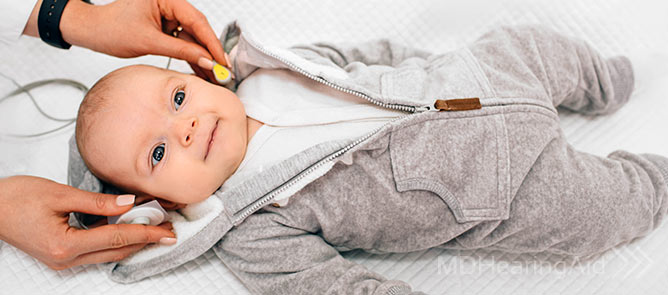‘Hearing Issues’ is our ongoing series where the MDHearing team goes in-depth on specific ear problems, hearing issues, and hearing aid terminology. We believe knowledge is power, and our aim is to help all our customers better understand their own hearing health. This time, the topic is auditory neuropathy.
What is auditory neuropathy?
Auditory neuropathy is a very serious hearing disorder involving the brain. With this disorder, the inner ear itself is still able to detect sound, but it has a problem sending the signal from the ear to the brain. This could come from the processing ability of the brain itself or it could be the actual pathway. Other causes may be inner hair cell damage, nerve damage, genetic factors, or any combination of these things.
While adults can develop this disorder through age-related hearing loss, it’s most well-known for being diagnosed in early childhood or infancy. This can be due to health problems as newborns or prior to birth, but it can also come from dietary thiamine deficiency or premature birth.
Parents can look out for these auditory neuropathy symptoms and red flags in toddlers:
- They don’t turn towards voices
- They don’t react to loud noises
- They aren’t trying to imitate sounds or cooing
- They don’t seem to be paying attention to you calling their name
Unfortunately, auditory neuropathy is often very difficult for hearing clinics to diagnose compared to other hearing loss issues because the audiogram could look like hearing within normal limits, even though the person is struggling with poor speech recognition. On the other hand, it could also look like a mild to severe hearing loss that happens to come with poorer speech recognition than would be predicted based on their hearing loss.
Unfortunately, the hearing aids need to be programmed very specifically to this issue, and getting the wrong type of hearing device for this kind of disorder could actually cause even more cognitive stress.
If you think your child might have something beyond common hearing loss, it’s best to visit an audiologist who has experience and expertise in auditory neuropathy.
So how DO you diagnose auditory neuropathy?
Because of the seriousness of the disease, auditory neuropathy must be diagnosed and treated by ENTs and audiologists. Diagnosis is done with a combination of tests, most often an Auditory Brainstem Response test (ABR) and Otoacoustic Emissions test (OAE).
In ABR, the doctor will place electrodes on the patient’s head. The computer will then record the brain wave patterns as the patient hears different sounds via headphones. All the little patient has to do is rest and listen.
In OAE, a special earphone will be put in the patient’s ear. As sound is played through the earphone, it will also record any sounds that reverberate back. You see, the hair cells in the inner ear produce vibration — if the OAE doesn’t pick up those vibrations, that’s a sign there’s a problem. That could mean some form of hearing loss, but it could also mean a more complicated issue, like auditory neuropathy.
Auditory Neuropathy Treatments
It’s important to remember that while it’s a serious disorder, auditory neuropathy can be treated and managed, and so many children with the disorder grow up to live fulfilling, independent lives.
Probably the most well-known treatment is the cochlear implant, which has been commercially available in the United States for decades. A cochlear implant is a small, but very complex piece of technology that is surgically implanted deep in the ear and connects to a transmitter behind the ear.
Unlike a hearing aid receiver that sits in the ear canal to project sound, a cochlear implant stimulates the auditory nerves directly, generating signals that are interpreted by the brain as sound. While this isn’t a cure (and can’t completely replicate perfect hearing), the implant makes a huge difference for those with auditory neuropathy who want to more safely navigate the world. Because this is a serious surgical procedure, the implant tends to only be referred for serious issues like auditory neuropathy or moderately-severe to profound forms of sensorineural hearing loss.
However, cochlear implants are not the only treatments for this issue. There are hearing aids that can be programmed to work well for patients with auditory neuropathy. There are also personal listening devices on the market that help patients communicate with those around them. As neuropathic technology develops more and more, those with auditory neuropathy will have many more options.
There’s also ongoing debates on how to build communication for children and babies with hearing impairments. Teaching sign language early, encouraging listening skills along with the cochlear implant, and gradually teaching to read lips are all valid approaches. It just depends on the individual child and what they need. Not every approach will work for every kid, and it’s just as important for you to listen to your child’s needs as it is for them to learn how to hear themselves.
There are many different kinds of hearing loss, some more common than you’d expect.
LEARN MORE


